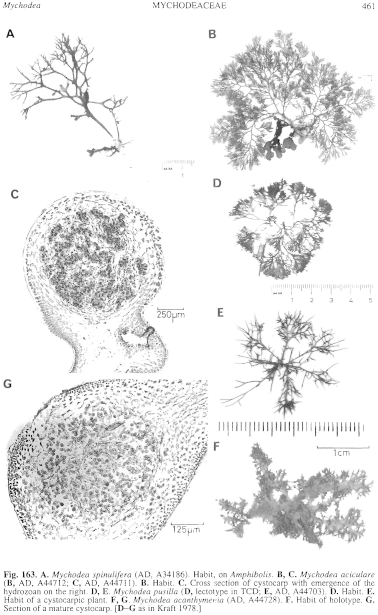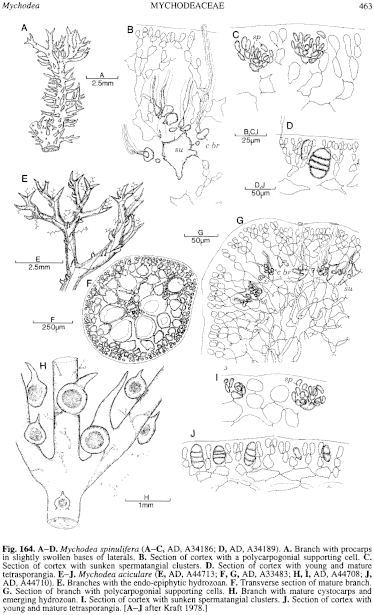|
|
|
|
|
|||||||||||
|
Electronic Flora of South Australia Species Fact Sheet
Phylum Rhodophyta – Class Florideophyceae – Order Gigartinales – Family Mychodeaceae
Synonyms
Cystoclonium aciculare J. Agardh 1849: 87.
Acanthococcus acicularis (J. Agardh) J. Agardh 1852: 436. Harvey 1863, synop.: xxxvii.
Gracilaria aculeolata Areschoug 1854: 352.
Mychodea muelleri Sonder 1853: 679.
Mychodea carnosa sensu Harvey and other authors (see Kraft 1978, p. 555).
Thallus (Fig. 163B) medium to dark red-brown, firm, 10–20 (–40) cm high, irregularly alternately and radially branched, main branches subdichotomous, terete, laterals 2–10 mm apart, 0.5–2 mm in diameter below, 200–500 µm in upper parts, with numerous scattered, often curved, spines 0.5–1 mm long. Most branches, to near the tips, are infested with the partly endophytic hydrozoan Plumularia flexuosa Bale (Fig. 164E). Holdfast originally discoid, later attached by a mat of hydrozoan tubes and by tendril-like ends to some lower branches; epiphytic on Amphibolis and various larger algae, epizoic on tunicates and sponges, and on rock. Structure (Fig. 164F) uniaxial, with a persistent axial filament in the filamentous inner medulla, a large-celled outer medulla with few filaments, and a cortex of filaments of ovoid cells, the outer ones 4–8 µm in diameter. Rhodoplasts discoid to elongate, ribbon like in inner cells.
Reproduction: Sexual thalli monoecious; procarpic; polycarpogonial. Carpogonial branches (Fig. 164G) 3-celled, 2–6 borne on inner cortical cells, with the auxiliary cell producing gonimoblast initials mainly thallus-inwards, then forming rows and clusters of ovoid carposporangia 10–15 µm in diameter within the filamentous matrix (Fig. 163C). Cystocarps (Fig. 164H) developing in the base of the short spines, subspherical, 0.5–1 mm in diameter, with a prominent spine apex; enveloping tissue slight, cortex normal. Spermatangial clusters (Fig. 164I) scattered, sunken in the cortex, with the initials producing 2–3 ovoid spermatangia 2–4 µm in diameter.
Tetrasporangia (Fig. 164J) scattered in the outer cortex, more or less basally attached, ovoid, 25–35 µm long and 15–20 µm in diameter, zonately divided.
Type from "Occid. Nov. Holl."; lectotype in Herb. Agardh, LD, 33993.
Selected specimens: Cape Riche, W. Aust., (Harvey, Feb. 1854; TCD, Alg. Aust. Exsicc. 411C). Tapley Shoal, S. Aust., 10 m deep (Shepherd, 2.ii.1969; AD, A33483 -"Marine Algae of southern Australia" No. 207). Port Noarlunga, S. Aust., 24 m deep (Ottaway, 3.ii.1981; AD, A52090). Vivonne Bay, Kangaroo I., S. Aust., on jetty piles, 3–6 m deep (Kraft, 3.xii.1971, 6.iv.1972 and 15.iv.1973; AD, A44708, A44711, A44710 respectively). Robe, S. Aust., 5–6 m deep on jetty (Kraft, 12.ii.1972; AD, A44712) and 2 m deep by jetty (Kraft, 10.ii.1973; AD, A44713). Bridgewater Bay, Vic., drift (Beauglehole, 26.xii.1950; AD, A15583). Portsea, Vic., 5 m deep on jetty (Kraft & Ricker, 16.iii.1979; MELU, K6894). San Remo, Vic., 5 m deep on pylons (Berthold, 16.ii.1990; AD, A60205 -"Marine Algae of southern Australia" No. 207a). Walkerville, Vic., drift (Sinkora A1621, 23.ii.1972; AD, A43152). North Cape, Stanley, Tas., 10 m deep (AIMS-NCI, Q66C 4980-F, 10.ii.1991; AD, A61350). Birchs Bay, D'Entrecasteaux Ch., Tas. (Rushton & Baily, March 1991; AD, A61249). Tinderbox, Tas., 6–10 m deep (Kraft & Sanderson, 20.xii.1992; MELU, K9226).
Distribution: Cape Riche, W. Aust., to Walkerville, Vic., and around Tasmania.
Taxonomic notes: M. aciculare is characterised by the terete, cartilaginous, branches, prominent axial filament throughout, position of the cystocarps, and by the presence of the hydrozoan. It is a common species, from just subtidal to 24 m deep, in moderately sheltered localities, and appears to be largely a summer annual. It grows on rocks, wooden pilings, and more rarely as an epiphyte or epizoic.
References:
AGARDH, J.G. (1849). Algologiska bidrag. Öfvers. K. Svenska Vetensk. Akad. Rh-h. 6(3), 79–89.
AGARDH, J.G. (1852). Species Genera et Ordines Algarum. Vol. 2, Part 2, pp. 337–720. (Gleerup: Lund.)
ARESCHOUG, J.E. (1854). Phyceae novae et minus cognitae in maribus extraeuropaeis collectae. Ups. Soc. Sci. nova Acta, Ser. III, 1, 329–72.
HARVEY, W.H. (1863). Phycologia Australica. Vol. 5, Plates 241–300, synop., pp. i-lxxiii. (Reeve: London.)
KRAFT, G.T. (1978). Studies of marine algae in the lesser-known families of the Gigartinales (Rhodophyta). III. The Mychodeaceae and Mychodeophyllaceae. Aust. J. Bot. 26, 515–610.
SONDER, O.W. (1853). Plantae Muellerianae. Algae. Linnaea 25, 657–709.
The Marine Benthic Flora of Southern Australia Part IIIA complete list of references.
Publication:
Womersley, H.B.S. (14 January, 1994)
The Marine Benthic Flora of Southern Australia
Rhodophyta. Part IIIA, Bangiophyceae and Florideophyceae (to Gigartinales)
Reproduced with permission from The Marine Benthic Flora of Southern Australia Part IIIA 1994, by H.B.S. Womersley. Australian Biological Resources Study, Canberra. Copyright Commonwealth of Australia.
Illustrations in Womersley Part IIIA, 1994: FIGS 163B, C, 164 E–J.

Figure 163 enlarge
Fig. 163. A. Mychodea spinulifera (AD, A34186). Habit, on Amphibolis. B, C. Mychodea aciculare (B, AD, A44712; C, AD, A44711). B. Habit. C. Cross section of cystocarp with emergence of the hydrozoan on the right. D, E. Mychodea pusilla (D, lectotype in TCD; E, AD, A44703). D. Habit. E. Habit of a cystocarpic plant. F, G. Mychodea acanthymenia (AD, A44728). F. Habit of holotype. G. Section of a mature cystocarp. [D–G as in Kraft 1978.]

Figure 164 enlarge
Fig. 164. A–D. Mychodea spinulifera (A–C, AD, A34186; D, AD, A34189). A. Branch with procarps in slightly swollen bases of laterals. B. Section of cortex with a polycarpogonial supporting cell. C. Section of cortex with sunken spermatangial clusters. D. Section of cortex with young and mature tetrasporangia. Mychodea aciculare (E, AD, A44713; F, G, AD, A33483; H, I, AD, A44708; J, AD, A44710). E. Branches with the endo-epiphytic hydrozoan. F. Transverse section of mature branch. G. Section of branch with polycarpogonial supporting cells. H. Branch with mature cystocarps and emerging hydrozoan. I. Section of cortex with sunken spermatangial clusters. J. Section of cortex with young and mature tetrasporangia. [A–J after Kraft 1978.]

|
Email Contact: State Herbarium of South Australia |

|